
FACULTY OF ENGINEERING
Department of Genetics and Bioengineering
FE 251 | Course Introduction and Application Information
| Course Name |
Thermodynamics
|
|
Code
|
Semester
|
Theory
(hour/week) |
Application/Lab
(hour/week) |
Local Credits
|
ECTS
|
|
FE 251
|
Fall/Spring
|
2
|
2
|
3
|
5
|
| Prerequisites |
None
|
|||||
| Course Language |
English
|
|||||
| Course Type |
Service Course
|
|||||
| Course Level |
First Cycle
|
|||||
| Mode of Delivery | - | |||||
| Teaching Methods and Techniques of the Course | Problem SolvingQ&ALecture / Presentation | |||||
| Course Coordinator | ||||||
| Course Lecturer(s) | ||||||
| Assistant(s) | ||||||
| Course Objectives | Define the fundamental principles and laws of thermodynamics and apply them to simple food engineering systems |
| Learning Outcomes |
The students who succeeded in this course;
|
| Course Description | Definition of thermodynamics and its fields of use; open and closed systems; properties of pure substances; the first law of thermodynamics and related concepts (temperature, reversibility, work, and heat); second law of thermodynamics and entropy; chemical reaction thermodynamics; chemical equillibrium and phase equilibrium |
|
|
Core Courses | |
| Major Area Courses | ||
| Supportive Courses | ||
| Media and Management Skills Courses | ||
| Transferable Skill Courses |
WEEKLY SUBJECTS AND RELATED PREPARATION STUDIES
| Week | Subjects | Related Preparation |
| 1 | Introduction to thermodynamics and basic concepts | Çengel, YA; Boles, MA, “Thermodynamics: An Engineering Approach (8th Edition in SI Units)”, McGraw-Hill Education, New York, USA, 2015. Chapter 1 |
| 2 | Forms of energy and energy transfer by heat and work, general concepts of bio-heat transfer | • Çengel, YA; Boles, MA, “Thermodynamics: An Engineering Approach (8th Edition in SI Units)”, McGraw-Hill Education, New York, USA, 2015. Chapter 2 • Truskey, GA; Yuan, F; Katz, DF, ‘‘Transport Phenomena in Biological Systems (2nd Edition)’’, Pearson Prentice Hall Bioengineering, New Jersey, USA, 2010. Chapter 17 |
| 3 | The first law of thermodynamics, conservation and conversion of energy | Çengel, YA; Boles, MA, “Thermodynamics: An Engineering Approach (8th Edition in SI Units)”, McGraw-Hill Education, New York, USA, 2015. Chapter 2 |
| 4 | Properties of pure substances, phase-change processes | Çengel, YA; Boles, MA, “Thermodynamics: An Engineering Approach (8th Edition in SI Units)”, McGraw-Hill Education, New York, USA, 2015. Chapter 3 |
| 5 | Property tables and equations of state | Çengel, YA; Boles, MA, “Thermodynamics: An Engineering Approach (8th Edition in SI Units)”, McGraw-Hill Education, New York, USA, 2015. Chapter 3 |
| 6 | Energy analysis of closed systems, internal energy, enthalpy and specific heat | Çengel, YA; Boles, MA, “Thermodynamics: An Engineering Approach (8th Edition in SI Units)”, McGraw-Hill Education, New York, USA, 2015. Chapter 4 |
| 7 | Mass and energy analysis of open systems, conservation of mass, flow work and energy of a flowing fluid | Çengel, YA; Boles, MA, “Thermodynamics: An Engineering Approach (8th Edition in SI Units)”, McGraw-Hill Education, New York, USA, 2015. Chapter 5 |
| 8 | Midterm | |
| 9 | Chemical kinetics and reaction mechanisms, reaction rate laws and stoichiometry | • Truskey, GA; Yuan, F; Katz, DF, ‘‘Transport Phenomena in Biological Systems (2nd Edition)’’, Pearson Prentice Hall Bioengineering, New Jersey, USA, 2010. Chapter 10 • H. Scott Fogler, ‘‘Elements of Chemical Reaction Engineering’’, 3rd Edition, Prentice Hall International, New Jersey, USA, 1999. Chapter 3 |
| 10 | First order reactions, second order irreversible reactions, reversible reactions, material balances and mass transfer upon biochemical interactions. | • Truskey, GA; Yuan, F; Katz, DF, ‘‘Transport Phenomena in Biological Systems (2nd Edition)’’, Pearson Prentice Hall Bioengineering, New Jersey, USA, 2010. Chapter 10 • H. Scott Fogler, ‘‘Elements of Chemical Reaction Engineering’’, 3rd Edition, Prentice Hall International, New Jersey, USA, 1999. Chapter 3 |
| 11 | Fundamentals of enzymatic reaction, enzyme kinetics, derivation of Michaelis-Menten kinetics | • Truskey, GA; Yuan, F; Katz, DF, ‘‘Transport Phenomena in Biological Systems (2nd Edition)’’, Pearson Prentice Hall Bioengineering, New Jersey, USA, 2010. Chapter 10 • H. Scott Fogler, ‘‘Elements of Chemical Reaction Engineering’’, 3rd Edition, Prentice Hall International, New Jersey, USA, 1999. Chapter 7 |
| 12 | Chemical reaction thermodynamics | Çengel, YA; Boles, MA, “Thermodynamics: An Engineering Approach (8th Edition in SI Units)”, McGraw-Hill Education, New York, USA, 2015. Chapter 15 |
| 13 | The second law of thermodynamics | Çengel, YA; Boles, MA, “Thermodynamics: An Engineering Approach (8th Edition in SI Units)”, McGraw-Hill Education, New York, USA, 2015. Chapter 6 |
| 14 | The concept of entropy | Çengel, YA; Boles, MA, “Thermodynamics: An Engineering Approach (8th Edition in SI Units)”, McGraw-Hill Education, New York, USA, 2015. Chapter 7 |
| 15 | Semester Review | |
| 16 | Final Exam |
| Course Notes/Textbooks | Çengel, YA; Boles, MA, “Thermodynamics: An Engineering Approach (8th Edition in SI Units)”, McGraw-Hill Education, New York, USA, 2015. ISBN: 978-981-4595-29-2. |
| Suggested Readings/Materials | Truskey, GA; Yuan, F; Katz, DF, ‘‘Transport Phenomena in Biological Systems (2nd Edition)’’, Pearson Prentice Hall Bioengineering, New Jersey, USA, 2010. ISBN: 978-0130422040. H. Scott Fogler, ‘‘Elements of Chemical Reaction Engineering’’, 3rd Edition, Prentice Hall International, New Jersey, USA, 1999. ISBN: 0-13-973785-5. |
EVALUATION SYSTEM
| Semester Activities | Number | Weigthing |
| Participation | ||
| Laboratory / Application | ||
| Field Work | ||
| Quizzes / Studio Critiques | ||
| Portfolio | ||
| Homework / Assignments |
1
|
20
|
| Presentation / Jury | ||
| Project | ||
| Seminar / Workshop | ||
| Oral Exams | ||
| Midterm |
1
|
40
|
| Final Exam |
1
|
40
|
| Total |
| Weighting of Semester Activities on the Final Grade |
2
|
60
|
| Weighting of End-of-Semester Activities on the Final Grade |
1
|
40
|
| Total |
ECTS / WORKLOAD TABLE
| Semester Activities | Number | Duration (Hours) | Workload |
|---|---|---|---|
| Theoretical Course Hours (Including exam week: 16 x total hours) |
16
|
4
|
64
|
| Laboratory / Application Hours (Including exam week: '.16.' x total hours) |
16
|
0
|
|
| Study Hours Out of Class |
14
|
2
|
28
|
| Field Work |
0
|
||
| Quizzes / Studio Critiques |
0
|
||
| Portfolio |
0
|
||
| Homework / Assignments |
5
|
4
|
20
|
| Presentation / Jury |
0
|
||
| Project |
0
|
||
| Seminar / Workshop |
0
|
||
| Oral Exam |
0
|
||
| Midterms |
1
|
18
|
18
|
| Final Exam |
1
|
20
|
20
|
| Total |
150
|
COURSE LEARNING OUTCOMES AND PROGRAM QUALIFICATIONS RELATIONSHIP
|
#
|
Program Competencies/Outcomes |
* Contribution Level
|
||||
|
1
|
2
|
3
|
4
|
5
|
||
| 1 | To have adequate knowledge in Mathematics, Science and Genetics and Bioengineering; to be able to use theoretical and applied information in these areas on complex engineering problems. |
|||||
| 2 | To be able to identify, define, formulate, and solve complex Genetics and Bioengineering problems; to be able to select and apply proper analysis and modeling methods for this purpose. |
|||||
| 3 | To be able to design a complex system, process, device or product under realistic constraints and conditions, in such a way as to meet the requirements; to be able to apply modern design methods for this purpose. |
|||||
| 4 | To be able to devise, select, and use modern techniques and tools needed for analysis and solution of complex problems in Genetics and Bioengineering applications; to be able to use information technologies effectively. |
|||||
| 5 | To be able to design and conduct experiments, gather data, analyze and interpret results for investigating complex engineering problems or Genetics and Bioengineering research topics. |
|||||
| 6 | To be able to work efficiently in Genetics and Bioengineering disciplinary and multi-disciplinary teams; to be able to work individually. |
|||||
| 7 | To be able to communicate effectively in Turkish, both orally and in writing; to be able to author and comprehend written reports, to be able to prepare design and implementation reports, to present effectively, to be able to give and receive clear and comprehensible instructions. |
|||||
| 8 | To have knowledge about global and social impact of Genetics and Bioengineering practices on health, environment, and safety; to have knowledge about contemporary issues as they pertain to engineering; to be aware of the legal ramifications of Genetics and Bioengineering solutions. |
|||||
| 9 | To be aware of ethical behavior, professional and ethical responsibility; to have knowledge about standards utilized in Genetics and Bioengineering applications. |
|||||
| 10 | To have knowledge about industrial practices such as project management, risk management, and change management; to have awareness of entrepreneurship and innovation; to have knowledge about sustainable development. |
|||||
| 11 | To be able to collect data in the area of Genetics and Bioengineering, and to be able to communicate with colleagues in a foreign language. |
|||||
| 12 | To be able to speak a second foreign language at a medium level of fluency efficiently. |
|||||
| 13 | To recognize the need for lifelong learning; to be able to access information, to be able to stay current with developments in science and technology; to be able to relate the knowledge accumulated throughout the human history to Genetics and Bioengineering. |
|||||
*1 Lowest, 2 Low, 3 Average, 4 High, 5 Highest
NEWS |ALL NEWS
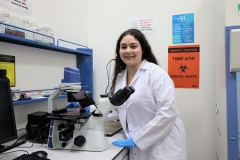
Germany chose Ezgi
Ezgi Kaya, who graduated from Izmir University of Economics (IUE) Department of Genetics and Bioengineering this year, was accepted to the world-famous
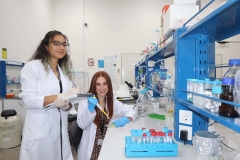
Geneticists’ success in ‘Germany’
Nine newly graduated students from Izmir University of Economics (IUE) Department of Genetics and Bioengineering achieved great success by being accepted to
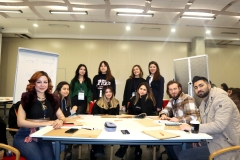
'Sustainable energy' ideas from students
Izmir University of Economics (IUE) organized a workshop on biohydrogen, which is used in many fields from industry to transportation and stands
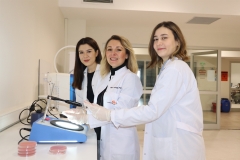
Discovery in thermal spring
Asst. Prof. Dr. Mine Güngörmüşler from Izmir University of Economics (IUE), Department of Genetics and Bioengineering, and two graduate students examined the
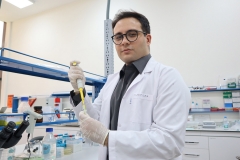
Arda ranked among 7 people in the world
Arda Kıpçak, who graduated from Department of Genetics and Bioengineering, Izmir University of Economics (IUE) this year, was accepted to the world-renowned
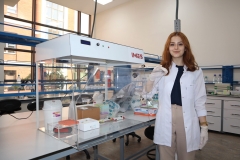
'Smart cabinet' against the virus
Assoc. Prof. Dr. Osman Doluca and his 4 students from Izmir University of Economics (IUE) developed a 'PCR cabinet' that allows samples
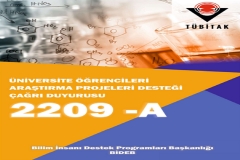
Our Senior Students are Granted Support by TÜBİTAK for Their Graduation Projects
Five of our students are entitled to receive support from TÜBİTAK (The Scientific and Technological Research Council of Turkey) within the scope
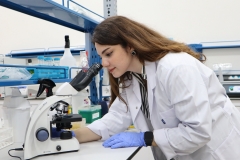
American universities welcome Aydolun with open arms
Aydolun Petenkaya, who completed Izmir University of Economics (IUE) Department of Genetics and Bioengineering as a top student with a full scholarship
